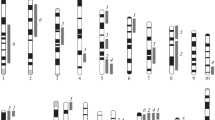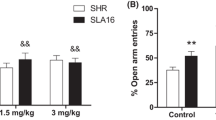The role of mouse chromosome 13 fragment 57-65 cM in regulating the actions of ethanol on motor activity, anxiety, and sensitivity to the hypnotic and hypothermic effects of ethanol was studied. Male AKR/J mice and recombinant strain AKR.CBA-D13Mit76C, which differ only in terms of this fragment, were used. After acute administration of ethanol, only AKR mice showed an increase in trajectory length in the open field test (p < 0.05), while only AKR.CBA-D13Mit76C mice showed an increase in the time taken to find the center of the open field arena (p < 0.05). There were no differences in sleep duration or the intensity of hypothermia induced by injections of large doses of ethanol in intact animals of both strains. At the same time, prolonged alcoholization led to weakening of the hypnotic effect of ethanol in males of both strains as compared with intact animals (p < 0.01 for AKR, p < 0.001 for AKR.CBA-D13Mit76C). Chronic alcoholization led to an increase in ethanol-induced hypothermia in AKR males as compared with intact animals (p < 0.01) but had no effect on the severity of the hypothermic effect of ethanol in AKR.CBA-D13Mit76C mice. These results provide evidence that the distal fragment 57-65 cM of chromosome 13 has a role in the mechanisms of action of ethanol in mice.
Similar content being viewed by others
References
E. M. Kondaurova, D. V. Bazovkina, and A. V. Kulikov, “Studies of the interaction of catalepsy with anxiety, aggress, and depression-like behavior using congenic mouse strains,” Ros. Fiziol. Zh., 96, 464–471 (2010).
A. V. Kulikov, V. S. Naumenko, D. V. Bazovkina, et al., “Effects of the terminal fragment of chromosome 13 on the predisposition to catalepsy and the expression of genes encoding tryptophan hydroxylase-2, the serotonin transporter, and 5-HT1A receptors in the brain,” Byull. Eksperim. Biol. Med., 147, No. 5, 553–556 (2009).
G. K. Aghajanian, J. S. Sprouse, P. Sheldon, and K. Rasmussen, “Electrophysiology of the central serotonin system: receptor subtypes and transducer mechanisms,” Ann. N.Y. Acad. Sci., 600, 93–103 (1990).
S. C. Altieri, A. L. Garcia-Garcia, E. D. Leonardo, and A. M. Andrews, “Rethinking 5-HT1A receptors: emerging modes of inhibitory feedback of relevance to emotion-related behavior,” ACS Chem. Neurosci., 4, No. 1, 72–83 (2013).
B. Bennett, C. Downing, C. Parker, and T. E. Johnson, “Mouse genetic models in alcohol research,” Trends Genet., 22, No. 7, 367–374 (2006).
H. H. Berendsen and C. L. Broekkamp, “Behavioural evidence for functional interactions between 5-HT-receptor subtypes in rats and mice,” Br. J. Pharmacol., 101, 667–673 (1990).
S. L. Boehm, II, C. L. Reed, C. S. McKinnon, and T. J. Phillips, “Shared genes influence sensitivity to the effects of ethanol on locomotor and anxiety-like behaviors, and the stress axis,” Psychopharmacology (Berlin), 161, No. 1, 54–63 (2002).
K. A. Clissold, E. Choi, and W. E. Pratt, “Serotonin 1A, 1B and 7 receptors of the rat medial nucleus accumbens differentially regulate feeding, water intake, and locomotor activity,” Pharmacol. Biochem. Behav., 112, 96–103 (2013).
J. C. Crabbe, T. J. Phillips, and J. K. Belknap, “The complexity of alcohol drinking: studies in rodent genetic models,” Behav. Genet., 40, No. 6, 737–750 (2010).
Z. R. Donaldson, K. M. Nautiyal, S. E. Ahmari, and R. Hen, “Genetic approaches for understanding the role of serotonin receptors in mood and behavior,” Curr. Opin. Neurobiol., 23, No. 3, 399–406 (2013).
F. Ducci and D. Goldman, “Genetic approaches to addiction: genes and alcohol,” Addiction, 103, No. 9, 1414–1428 (2008).
S. L. Handley, “5-Hydroxytryptamine pathways in anxiety and its treatment,” Pharmacol. Ther., 66, 103–148 (1995).
S. Hjorth and T. Sharp, “Effect of the 5-HT1A receptor agonist 8-OH-DPAT on the release of 5-HT in dorsal and median raphe-innervated rat brain regions as measured by in vivo microdialysis,” Life Sci., 48, 1779–1786 (1991).
H. Houchi, V. Warnault, E. Barbier, et al., “Involvement of A2A receptors in anxiolytic, locomotor and motivational properties of ethanol in mice,” Genes Brain Behav., 7, No. 8, 887–898 (2008).
S. R. Kameda, R. Frussa-Filho, R. C. Carvalho, et al., “Dissociation of the effects of ethanol on memory, anxiety, and motor behavior in mice tested in the plus-maze discriminative avoidance task,” Psychopharmacology (Berlin), 192, No. 1, 39–48 (2007).
S. Kelaï, T. Renoir, L. Chouchana, et al., “Chronic voluntary ethanol intake hypersensitizes 5-HT(1A) autoreceptors in C57BL/6J mice,” J. Neurochem., 107, No. 6, 1660–1670 (2008).
H. Kinoshita, D. S. Jessop, D. J. Roberts, et al., “Chronic ethanol administration and withdrawal decreases 5-HT1A mRNA, but not 5-HT4 expression in the rat hippocampus,” Pharmacol. Toxicol., 93, No. 2, 100–102 (2003).
A. V. Kulikov, D. V. Bazovkina, E. M. Kondaurova, and N. K. Popova, “Genetic structure of hereditary catalepsy in mice,” Genes Brain Behav., 7, No. 4, 506–512 (2008).
A. V. Kulikov, M. A. Tikhonova, and V. A. Kulikova, “Automated measurement of spatial preference in the open field test with transmitted lighting,” J. Neurosci. Meth., 170, No. 2, 345–351 (2008).
R. K. Manchanda, A. S. Jaggi, and N. Singh, “Ameliorative potential of sodium cromoglycate and diethyldithiocarbamic acid in restraint stress-induced behavioral alterations in rats,” Pharmacol. Rep., 63, No. 1, 54–63 (2011).
M. J. Millan, J. M. Rivet, H. Canton, et al., “Induction of hypothermia as a model of 5-hydroxytryptaminelA receptor-mediated activity in the rat: a pharmacological characterization of the actions of novel agonists and antagonists,” J. Pharmacol. Exp. Ther., 264, No. 3, 1364–1376 (1993).
J. M. Monti and H. Jantos, “Dose-dependent effects of the 5-HT1A receptor agonist 8-OH-DPAT on sleep and wakefulness in the rat,” J. Sleep Res., 1, No. 3, 169–175 (1992).
T. V. Morozova, T. F. Mackay, and R. R. Anholt, “Genetics and genomics of alcohol sensitivity,” Mol. Genet. Genomics, 289, No. 3, 253–269 (2014).
A. R. Ozburn, R. A. Harris, and Y. A. Blednov, “Chronic voluntary alcohol consumption results in tolerance to sedative/hypnotic and hypothermic effects of alcohol in hybrid mice,” Pharmacol. Biochem. Behav., 104, 33–39 (2013).
R. E. Rakel, “Long-term buspirone therapy for chronic anxiety: a multicenter international study to determine safety,” South Med. J., 83, 194–198 (1990).
T. Sharp and S. Hjorth, “Application of brain microdialysis to study the pharmacology of the 5-HT1A autoreceptor,” J. Neurosci. Meth., 34, 83–90 (1990).
E. H. Shen, J. D. Dorow, M. Huson, and T. J. Phillips, “Correlated responses to selection in FAST and SLOW mice: effects of ethanol on ataxia, temperature, sedation, and withdrawal,” Alcohol. Clin. Exp. Res., 20, No. 4, 688–696 (1996).
M. A. Tikhonova, A. V. Kulikova, D. V. Bazovkina, et al., “Hereditary catalepsy in mice is associated with the brain dysmorphology and altered stress response,” Behav. Brain Res., 243, 53–60 (2013).
A. Vakili, K. Tayebi, M. R. Jafari, et al., “Effect of ethanol on morphine state-dependent learning in the mouse: involvement of GABAergic, opioidergic and cholinergic systems,” Alcohol Alcohol., 39, No. 5, 427–432 (2004).
T. G. Viana, A. F. Almeida-Santon, D. C. Aguiar, and F. A. Moreira, “Effects of aripiprazole, an atypical antipsychotic, on the motor alterations induced by acute ethanol administration in mice,” Basic Clin. Pharmacol. Toxicol., 112, No. 5,319–324 (2013).
D. F. Werner, A. R. Swihart, C. Ferguson, et al., “Alcohol-induced tolerance and physical dependence in mice with ethanol insensitive alpha1 GABA A receptors,” Alcohol Clin. Exp. Res., 3, No. 2, 289–299 (2009).
Author information
Authors and Affiliations
Corresponding author
Additional information
Translated from Rossiiskii Fiziologicheskii Zhurnal imeni I. M. Sechenova, Vol. 101, No. 1, pp. 25–34, January, 2015.
Rights and permissions
About this article
Cite this article
Bazovkina, D.V., Kulikov, A.V. Involvement of the Distal Fragment of Chromosome 13 in the Regulation of Sensitivity to Ethanol in Mice. Neurosci Behav Physi 46, 566–570 (2016). https://doi.org/10.1007/s11055-016-0278-x
Received:
Published:
Issue Date:
DOI: https://doi.org/10.1007/s11055-016-0278-x




